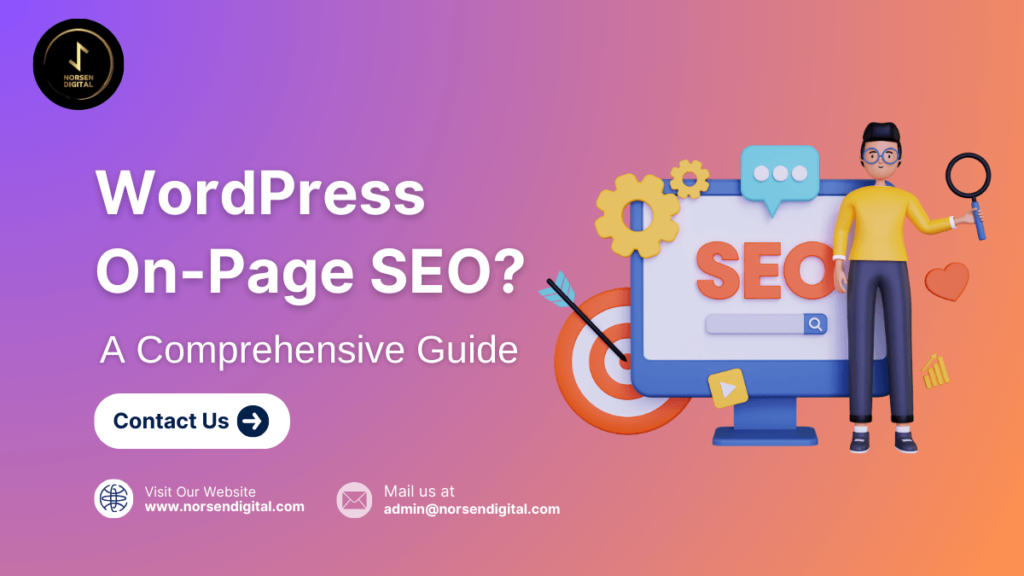Optimizing your WordPress website for on-page SEO is critical for improving your search engine rankings and driving organic traffic. With WordPress being one of the most SEO-friendly CMS platforms, leveraging its tools and best practices can make a significant difference in your site’s performance. Here’s a step-by-step guide to mastering on-page SEO for your WordPress site.
1. Choose the Right SEO Plugin
Using a reliable SEO plugin simplifies many technical aspects of on-page SEO. Popular options include Yoast SEO, Rank Math, and All in One SEO Pack. These plugins provide guidance for optimizing titles, meta descriptions, keywords, and other SEO elements.
Steps:
- Install and activate an SEO plugin.
- Configure the plugin settings for your site’s needs.
- Use the content analysis features to optimize your posts and pages.
2. Conduct Keyword Research
Keyword research is the foundation of any successful on-page SEO strategy. Tools like Google Keyword Planner, Ahrefs, and SEMrush can help you find relevant keywords with high search volume and low competition.
Best Practices:
- Target long-tail keywords for better conversion rates.
- Use keywords naturally to avoid keyword stuffing.
- Map keywords to specific pages on your site.
3. Optimize Title Tags and Meta Descriptions
The title tag and meta description are the first elements users see on search engine results pages (SERPs). They should be compelling and keyword-rich.
Tips:
- Keep title tags under 60 characters and include your target keyword.
- Write meta descriptions within 155-160 characters, making them informative and engaging.
- Use your SEO plugin to preview how these elements appear on SERPs.
4. Use Heading Tags Properly
Proper use of heading tags (H1, H2, H3, etc.) enhances readability and signals search engines about the structure of your content.
Guidelines:
- Use only one H1 tag per page, typically for the title.
- Organize content with H2 and H3 tags for subheadings.
- Include keywords in headings where relevant, but avoid overuse.
5. Optimize Images
Images enhance user experience but can slow down your site if not optimized. Proper image SEO ensures fast load times and better rankings.
Steps:
- Compress images using tools like TinyPNG or ShortPixel.
- Use descriptive file names (e.g.,
wordpress-seo-tips.jpginstead ofIMG12345.jpg). - Add ALT text with relevant keywords to improve accessibility and SEO.
6. Focus on Content Quality
High-quality, relevant content keeps users engaged and signals to search engines that your site is valuable.
Content Tips:
- Write detailed, well-researched articles that solve user problems.
- Include internal and external links to authoritative sources.
- Update content regularly to keep it fresh and accurate.
7. Improve Page Speed
Page speed is a critical ranking factor. A fast-loading site improves user experience and reduces bounce rates.
How to Improve:
- Use caching plugins like WP Rocket or W3 Total Cache.
- Optimize your hosting by choosing providers like SiteGround or Kinsta.
- Minify CSS, JavaScript, and HTML files using tools like Autoptimize.
8. Use a Mobile-Responsive Design
With Google’s mobile-first indexing, having a mobile-friendly website is non-negotiable.
Checklist:
- Choose a responsive WordPress theme.
- Test your site’s mobile-friendliness using Google’s Mobile-Friendly Test.
- Optimize images and fonts for mobile devices.
9. Implement Schema Markup
Schema markup enhances how your content appears in search results, making it more interactive and visually appealing.
Steps:
- Use plugins like Schema Pro or Yoast SEO to add structured data.
- Add schemas for articles, products, events, and more.
- Test your schema using Google’s Structured Data Testing Tool.
10. Leverage Internal Linking
Internal links help distribute link equity across your site and guide users to related content.
Best Practices:
- Link to relevant pages within your site.
- Use descriptive anchor text with keywords.
- Avoid overloading pages with too many links.
11. Secure Your Site with HTTPS
Google favors secure websites. Ensure your site uses HTTPS by installing an SSL certificate.
Steps:
- Obtain an SSL certificate from your hosting provider.
- Use plugins like Really Simple SSL to configure HTTPS on WordPress.
- Regularly check for mixed content issues.
12. Monitor and Analyze Performance
On-page SEO isn’t a one-time task; it requires regular monitoring and adjustments.
Tools to Use:
- Google Analytics: Track traffic and user behavior.
- Google Search Console: Identify indexing issues and monitor keyword rankings.
- Your chosen SEO plugin for performance insights.
Final Thoughts
Optimizing your WordPress on-page SEO requires a blend of technical expertise and strategic content creation. By following these steps, you’ll be well on your way to improving your rankings, increasing traffic, and providing a better experience for your visitors.
For more tips on optimizing your WordPress site, check out Norsen Digital’s blog. Let us help you take your WordPress SEO strategy to the next level!
Need Help with WordPress Development and SEO?
If you’re looking to optimize your WordPress website or need expert assistance with SEO, Norsen Digital is here to help. Our team specializes in WordPress development and SEO services tailored to your business needs.
Contact us today at Norsen Digital to boost your website’s performance and achieve your goals!
